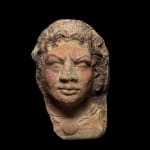Etruscan
An Etruscan terracotta antefix of a satyr, circa 3rd - 2nd century BC
Terracotta
Height: 21.9 cm
The antefix is in the form of a head of a young man with saturnine features and wearing a medallion round his neck. Much of the original red and brown...
The antefix is in the form of a head of a young man with saturnine features and wearing a medallion round his neck. Much of the original red and brown polychrome remains.
Provenance
American private collection, New York, acquired in the late 1960s – early 1970sWith Antiquarium, Ltd., New York, circa 1981
Literature
During the Archaic period, southern Etruria produced a large number of architectural terracottas (friezes, covering plaques, acroteria, and antefixes) designed to decorate sacred buildings.Etruscan temples were largely built from perishable materials: wood, bricks, or blocks of tuff for the superstructure; stone for the base. Antefixes had three functions: placed on the eaves of the roof they concealed the ends of the convex tiles and protected them from bad weather; they were also part of the architectural decoration; finally, they had an apotropaic role, banishing bad luck and bad influences from temples.
Made in moulds and painted, they usually took the form of a male or female face. On temple roofs, satyr-head antefixes often alternate with maenad antefixes. There is a similar satyr head antefix in the J. Paul Getty Museum, Los Angeles, object no.98.AD.133.



